|
| John Steven McGroarty was born 20 Aug 1862, at the family home at
Buck Mountain, in Foster
Township, near Wilkes-Barre ,
Luzerne County, Pennsylvania, the youngest of 12 children born to Hugh and
Mary M. McGroarty, both natives of Donegal, Ireland (she from Glenties,
he from an adjoining Parish). |
| He was born a month before Lincoln's Emancipation Proclamation
freed the slaves. One month before his first birthday the Battle of
Gettysburg in his native State orphaned the baby girl who would become his
bride. |
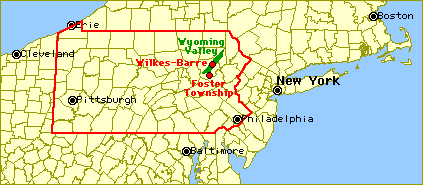 original
map source (since modified): Tiger Mapping
Service original
map source (since modified): Tiger Mapping
Service |
His Grandfather, Neill McGroarty, was born at Inver, Donegal,
Ire., Jun 1815 (at the time of the Battle of Waterloo). He eloped with
Nancy Mongtomery, niece of General Richard Montgomery of Donegal (friend
of George Washington, the first General to die in the War of Independence,
at the Battle of Quebec in 1775). In 1832 their youngest child, Hugh,
married Mary McGinty (b. 15 Aug 1817); they migrated to America in 1838
with two children, Mary and Bernard. Of the 12 McGroarty children, seven
survived childhood: Mary (b. Ireland, 1834, d. PA); Bernard (b. Ire.
1836, d. PA 1883); Bridget (b. ??, m. Thomas Farrell); Margaret (b. 1849
or 1850); Catherine (b. 14 Feb 1853 in Buckmountain PA, m. Michael F.
McHale 23 May 1874, had five children who survived childhood, d. 16 Jan
1937);
Hugh (b. ??, many children); John Steven, youngest of the twelve.
- genealogy
from Richard McHale of Riverside CA (Catherine's grandson), to Jane
Carroll McGroarty, 1988, who sent it to me, May 1997
More genealogical info (posted by Jane McGroarty): Cornelius McGroarty (son of James McGroarty and Susan Harvey) was the grandson of Bryan McGroarty (b. 1774 -d. 1840) and unknown wife. Bryan was the son of Neil McGroarty of the Townland of Kealogs, Parish of Inver, Co. Donegal (b.1746- d.1814) and Peggy Meehan (Meighan). Neil and Peggy had six sons and three daughters.
One of the other sons of Neil and Peggy was Neil McGroarty (b. 1780- d. 1815) who married Nancy Montgomery. Their son, Hugh Montgomery McGroarty (b.1805- d.1906), married Mary McGinty and emigrated to Luzerne County, PA. Hugh M. McGroarty and Mary McGinty were the parents of John Steven McGroarty, the poet laureate of Calif. |
| He showed marked intelligence at an early age, was educated in
the public schools, and received a state certificate to teach at age 16
which enabled him to complete his education at the Harry Willman Academy
(Wilkes-Barre) |
| He published his first poem at age 10; he had sent it the weekly
periodical, the Boston Pilot, without telling anyone. At age 19 he
began his journalistic career with the Wilkes-Barre Evening Leader
- one of the new Democratic papers in Pennylvania. |
| author: Poets and Poetry of Wyoming Valley (1885) |
| 19 Nov 1890 he married Ida Lubrecht, his childhood
sweetheart and a school teacher. They were married in her family home. |
Just prior to his wedding, he was elected Justice of the Peace at
age 21. At age 27 he was elected Treasurer of Luzerne County PA,
1890-1893, setting a new age record for that office in Pennsylvania. The City Directory lists him as County Treasurer, 616 Main St., 1891-92.
| Name | Occupation | Address | Year |
| Ida C. Lubrecht | teacher | bds 616 S.Main | 1890 |
| Louis H. Lubrecht | printer | bds 616 S.Main | 1890 |
| Mary L. Lubrecht | widow Christian | 616S.Main | 1890 |
| William B. Lubrecht | student | bds 616 S.Main | 1890 |
| William C. Lubrecht | teacher | bds 616 S.Main | 1891 |
| John S. McGroarty | county treasurer | 616 S.Main | 1891 |
| John S. McGroarty | county treas court house | 616 S.Main | 1892 |
|
| He studied law and was admitted to the bar 1894, aged 32, with a
practice in Wilkes-Barre |
| The Copper King, Marcus Daly of
Anaconda Copper Mining Co., pursuaded him to serve on his legal staff, and
in 1896 he moved to Montana, working in Butte and Anaconda MT. It may be
that, legal staff or no, his primary function was running a Butte light
company which Daly also owned. Ida McGroarty opened a boarding house for
the miners in Butte, apparently in the spring of 1899; 200 men are listed
in the account book, which runs about a year. According to his own later
account, John abhored the wars between Daly and William Andrew Clark for
political control of the state, not to mention the conflicts between
capital and labor, vowing to Ida to do something other than "wear a copper
collar" all his life. |
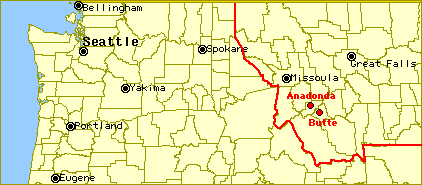 original
map source (since modified): Tiger Mapping
Service original
map source (since modified): Tiger Mapping
Service |
| After Mr. Daly's death in the Spring of 1900 he went with some
partners to Mexico on a mining venture. They invested all their
savings in a scheme which failed. |
| 21 Nov 1901 he and Ida arrived in Los Angeles. He was exhausted
and suffering from asthma. Ida put him up in a hotel room and went to work
for the Broadway Department Store. The death of the German munitions
manufacturer Friedrich Krupp, 22 Nov, inspired John to write a poem, "The Dead Gun Maker", which he sent to the Los Angeles
Times, which published it 24 Nov. This led to a friendship with
its publisher Harrison
Gray Otis; he worked as a journalist and was long the major editorial
writer of the Times, doing a column of homey (and later political)
comment. |
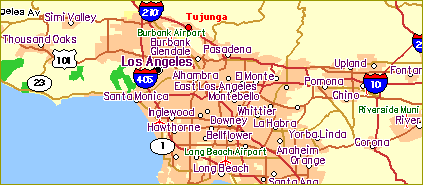 original
map source (since modified): Yahoo! maps original
map source (since modified): Yahoo! maps |
| author: Just California
(1903) The poem was inspired by Teddy Roosevelt's visit, 9 Nov, to San
Buenaventura Mission, where he said: "When I come here to California, I am
not in the West - I am west of the West - it is just California." The poem
appeared for many years in history textbooks of the California School
System, and generations of students were required to memorize
it. |
| In 1906 he became editor of the Grafton Publishing Company's
West Coast Magazine, primarily a vehicle for promoting the beauty
and living conditions in the cities of Southern California. He edited the
magazine until 1914. |
| author: Wander Songs (1908) |
| author: The King's Highway (1909) |
| author: California—Its History and Romance (1911)
which went through 10 editions in 13 years. |
| author: The Mission Play
(1911), a three hour pageant describing the California
Missions from their founding (1769) through secularization and final
ruin (1847); involving hundreds of actors, with more than two million paid
admissions, the play ran for twenty years at San Gabriel, and was revived
for the international exposition in San Diego in 1936. Frank Miller,
founder of the Mission Inn at Riverside CA, had seen the Oberammergau
Passion Play and wanted a Nativity play for Christmases at the Inn.
Stanford University President David Starr Jordan proposed McGroarty as
playwright and suggested a theme on California history. |
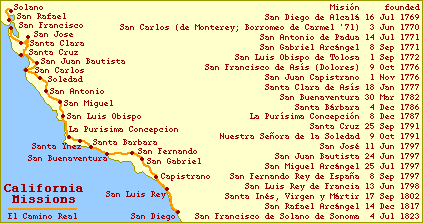 mission locations:
Bancroft Library
— there is an animated
version of this map
mission locations:
Bancroft Library
— there is an animated
version of this map |
Changes in the Illustrated Magazine of the Sunday Los
Angeles Times. In the Spring of 1918 is a full page written by him,
but without byline (except for a poem in a center box). Under a new
format, 2 Mar 1919, McGroarty's name appeared at the bottom of the page.
By 6 April the name was printed larger. By 31 Jul 1921 his byline moved to
the top of the page. 30 Dec 1923 his picture appeared, accompanied by "A
Page Conducted by John Steven McGroarty." Finally, 9 Jan 1927, in large
caps, his page is given the title "Seen From the Green Verdugo Hills."
While he served in Congress his column was often call "Seen From the
Capitol Dome."
- this, and much of the above, from "John Steven McGroarty:
One of the Last Compleat Journalists," by Viola L. Carlson - a talk given
to the Huntington Westerners on 24 Jan 1981; sent me by Jane Carroll
McGroarty, May 1997 |
| In 1923 he built "Rancho Chupa Rosa," as
his private residence, on the north side of the Verdugo Hills in Tujunga,
California. (relief map) |
| author: La Golondria (a drama of California) (1923) |
| Litt.D., University of California, 1925 |
| author: Osceola (a drama) (1927) |
| author: Babylon (drama) (1927) |
| LL.D., University of Santa Clara, 1927 |
| author: “Just California” and Other Poems
(1933) |
| author: California of the South: a History (1933) |
| By joint action of the Assembly and Senate of the State of
California, he was named Poet Laureate in 1933. He regarded this as his
greatest honor. The office is for life. Two poets had preceded him: Miss
Ina Collbrith of San Francisco and Henry Meade Bland of San Jose. |
| elected member of United States Congress (Democrat, 11th
District), served two terms, 3 Jan 1935 - 3 Jan 1939; did not stand for
reelection in 1938 |
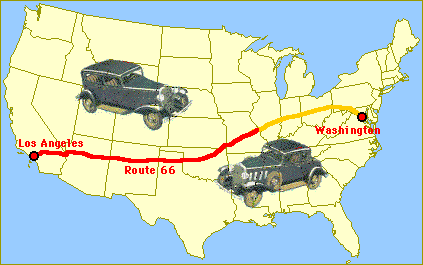 The 2,600 mile trip, over two-lane (some undeveloped) roads, using
1930s automobiles — a very long trip made at least wice yearly by the
McGroarty's and my parents; here are detailed maps and photos of Route 66 The 2,600 mile trip, over two-lane (some undeveloped) roads, using
1930s automobiles — a very long trip made at least wice yearly by the
McGroarty's and my parents; here are detailed maps and photos of Route 66 |
| He went to Congress pledged to support New Deal policies, but
left office a strong opponent of them. He opposed Roosevelt's
Supreme Court packing plan (5 Feb 37). |
| He was the champion in Congress of the Francis E. Townsend old
age pension plan, which would have given everyone over age 60 $200 a
month provided they left the work force and spent the money they received.
In 1936 he consented to have California delegates to the Democratic
National Convention pledged to him for President, but Dr. Townsend opposed
this move. He later introduced a "more conservative" version, limited to
$100 a month, to be paid for by a two percent tax on transactions. The
fight for the Townsend plan is generally agreed to have resulted in
creating the Social Security program. |
| In 1937, Congressman McGroarty was influential in getting the Los
Angeles County Board of Education to change the proposed "Calvin Coolidge
High School" to "Verdugo Hills
High School" (see map below). The first VHHS yearbook, El Portal,
was dedicated to him. The school auditorium is named for him. |
| Also in 1937, angered over its abuses of native Americans, McGroarty proposed abolishing the Bureau of Indian Affairs (H.J. Resolution 114, January 12, 1937). "He also spearheaded movements for the restoration of Olvera Street and the Missions, the reforestation of the San Gabriel mountains, and the construction of flood control dams throughout Los Angeles county" (Verdugo Online's Poet's Page). |
| In spite of his stated intention to retire from politics, he was
an unsuccessful candidate for Democratic nomination for secretary of state
of California, 1938 |
| Ida McGroarty, who had designed the costumes, stage settings and
color harmonies of her husband's Mission Play, and who had traveled to
Spain and Old Mexico to further her studies of these matters (she was a
graduate the the State College in Pennsylvania) passed away 13 May 1940,
after nearly fifty years of marriage |
| John Steven McGroarty died 7 Aug 1944, aged 81, in St. Vincent's
Hospital [the same hospital where I, his godson, had been born 27 Dec
1939], Los Angeles CA, attended by a small group of his closest relatives
and friends. His funeral Mass was held at St. Vibiana's Cathedral, The
Most Reverend John J. Cantwell, D.D., Archbishop of Los Angeles,
presiding, eulogy by Monsignor Martin Cody Keating. Interment was in Calvary
Cemetary in Los Angeles. |
| obituary:
New York Times, p. 17, 8 Aug 1944, portrait with original |
| On his death "Rancho Chupa Rosa" went,
through his will, to his niece, Miss Margaret McHale. In 1953, the City of
Los Angeles, Department of Recreation and Parks, purchased the home and 16
acres of adjoining land for only $30,000. The library was restored and
dedicated on May 19, 1974, as the John Steven McGroarty Memorial Archive
Library. The home, at 7570 McGroarty Terrace, now serves the public as
the McGroarty Arts Center under the direction of the City of Los Angeles
Cultural Affairs Department. The Cultural Heritage Commission declared it
an historical monument on February 4, 1970. |
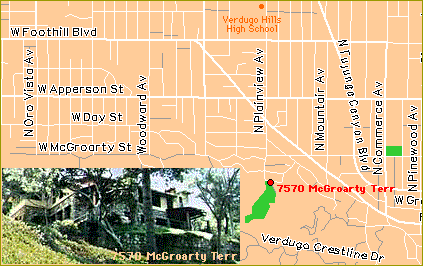 photo
source: David
Smith; original map source (since modified): Yahoo! maps photo
source: David
Smith; original map source (since modified): Yahoo! maps
|
Official
Congressional Biography
|